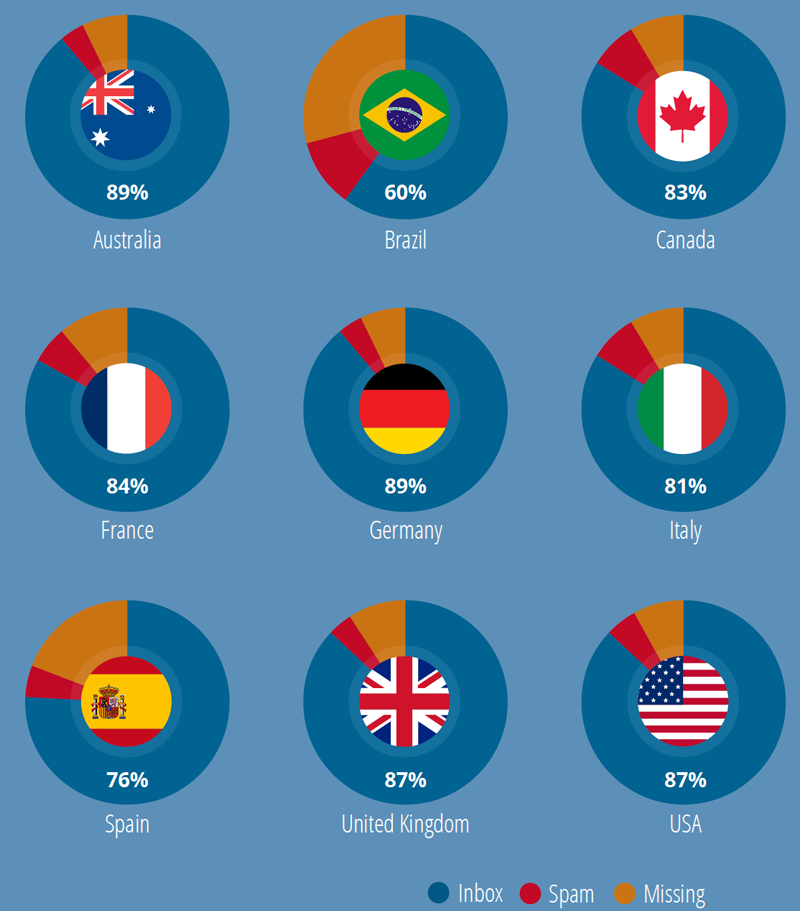Study: Email Deliverability Not Getting Any Easier
Legit permission-based emailers still have a hard time making it into the inbox. Contributor Tom Sather shares the latest research from Return Path.

According to the latest deliverability benchmark report from Return Path, my employer, one in six emails never reaches its intended recipient, either being delivered to spam or outright blocked.
Over the years, this rate has remained relatively consistent, plus or minus a few percentage points.
The reasons for these low rates of deliverability are the same as they have been in previous years, but are now combined with new spam filtering methods that would make even the most experienced marketers pull their hair out.
Global Inbox Placement Rates
Eighty-three percent of permission-based emails worldwide reached the inbox over the past 12 months, with 6% being sent to spam and 11% blocked.
These numbers are based on legitimate businesses using opt-in permission practices for growing their lists, and excludes the flagrant spam that still accounts for the vast majority of email received by ISPs.
Performance by country shows how unequal inbox placement rates are across the globe. Australia and Germany were able to deliver the most emails to the inbox, whereas Brazil struggled to even get a 60% inbox placement rate. Marketers in the U.S. did better than the global average with an inbox placement rate of 87%, but still had room to improve.

The global deliverability rate hasn’t changed much over the years for a couple of possible reasons. One, there are always new businesses and new marketers starting out that still need to know the basics of deliverability.
The second reason is that ISPs are changing the way emails are filtered. While reputation-based spam filters are highly effective at stopping spam, this methodology isn’t a silver bullet.
As a result, ISPs have been moving more toward engagement-based filtering that looks at individual subscriber signals to determine how and where email should be delivered.
The data used in engagement-based filtering is largely unavailable to marketers unless they work with a third party, making it a difficult issue to resolve.
Inbox Placement Rates Over Time
Looking at the average inbox placement rates on a monthly basis showed some surprises. September was the most difficult month to reach the inbox, while December and January were the easiest. This was a surprise.
Conventional wisdom tells us that as more businesses send more and more email during the holidays, more subscribers are likely to grow tired of handling the increased volume and use the “report spam” button more liberally.
While the data do show an increase in subscriber spam complaints, it wasn’t enough to increase the actual complaint rate. The same was somewhat true for September. As email volumes dropped at the end of summer, subscriber complaints remained constant and therefore showed a higher than average complaint rate.

The other reason for the higher-than-normal deliverability rates in December could be due to the rise of smartphones. In 2013, email open rates on smartphones were consistently above 50%, even reaching 60% on Christmas Day.
Smartphone users don’t have a “report spam” button, unless they’re using the email provider app like Gmail or Yahoo! rather than the native app. Subscribers are simply dealing with the influx by deleting more email, not reporting more as spam.
Another reason for the increase in deliverability rates is what can be referred to as the “cheer effect.” The holiday season has many people in the market for gifts for friends and family. One doesn’t have to look far from the spectacle of Black Friday to see what lengths people will go for a good deal. As a result, subscribers are more tolerant of promotional emails because it allows more access to special deals and offers.
Inbox Placement Rate By Industry
Deliverability rates by industry showed not only clear winners and losers, but how inconsistent inbox placement rates are when looking beyond the global average.
Health and Beauty brands scored the highest inbox placement rates with 96% of their emails being sent to the inbox. Retail and Apparel also saw higher than average inbox rates at 90% and 91%, respectively.
Software & Internet businesses performed the worst with only 43% of delivered emails reaching the inbox, followed by Technology, Media & Entertainment, Consumer Services and Biotechnology/Healthcare.

How Gmail’s Tabs Affect Deliverability
Once considered the death knell of email marketing, Gmail’s tabbed inbox seems to be having a positive influence on promotional emails’ inbox placement rates.
Gmail has long said that emails classified as Promotions will see fewer filtering issues. We decided to see if that was actually the case.
Looking at the Travel industry, we saw emails that were classified as “Primary” filtered much more heavily. In fact, only 2% of Travel emails classified as “Primary” ever reached the inbox, and of that 2% in Primary, none of them were read by subscribers.
On the other hand, the Travel emails classified as Promotions had an inbox placement rate of 99% and had a phenomenal read rate of 35%. In fact, we saw this pattern to be the case across most industries. The Promotions tab well outperformed the Primary tab on both inbox placement and read rates.

“As more things change, the more they stay the same” is an appropriate saying for the latest deliverability benchmarks.
While the worldwide average hasn’t moved much over the years, engagement-based spam filtering, smartphones, and inbox productivity tools have kept the path to the inbox as challenging as it was five and ten years ago, and will likely continue to do so for another ten.
Contributing authors are invited to create content for MarTech and are chosen for their expertise and contribution to the search community. Our contributors work under the oversight of the editorial staff and contributions are checked for quality and relevance to our readers. MarTech is owned by Semrush. Contributor was not asked to make any direct or indirect mentions of Semrush. The opinions they express are their own.
Related stories
New on MarTech